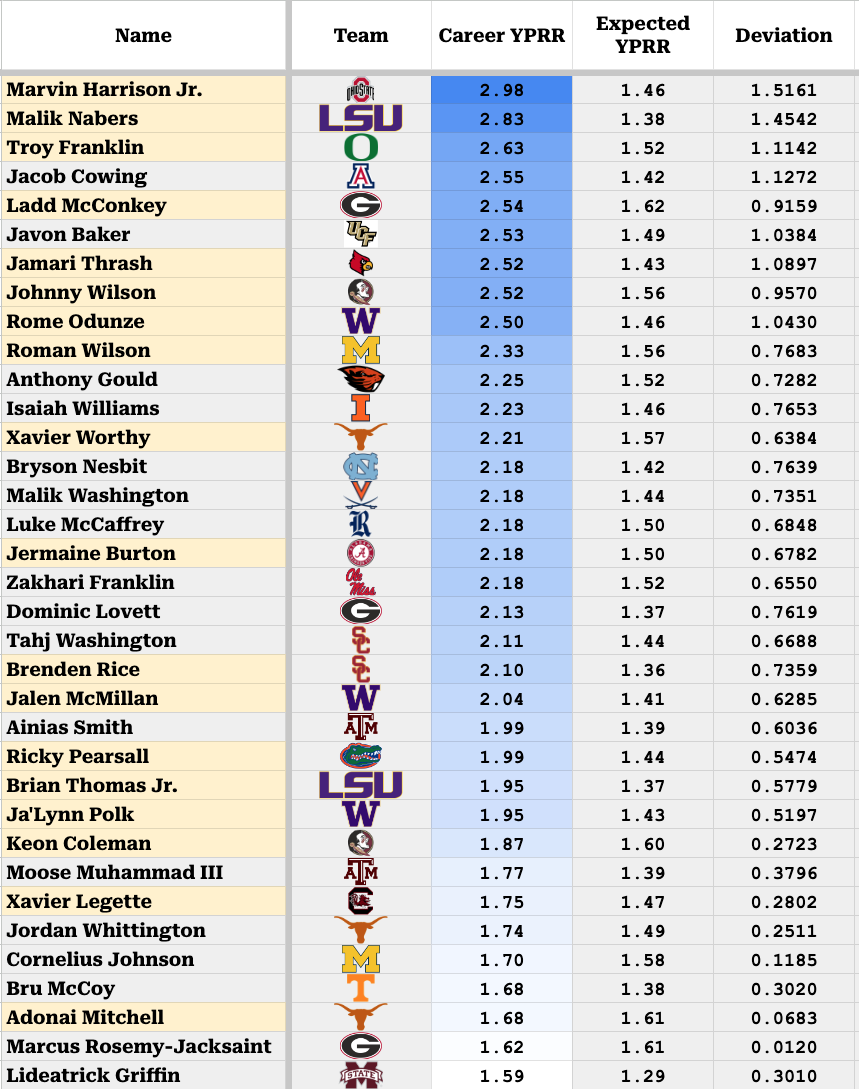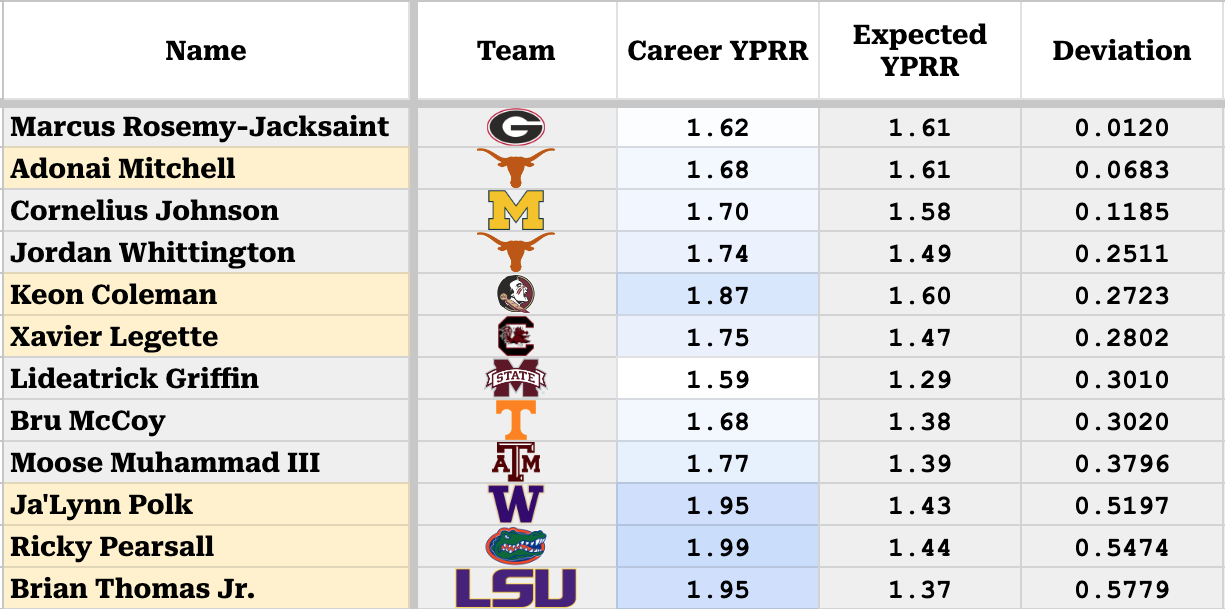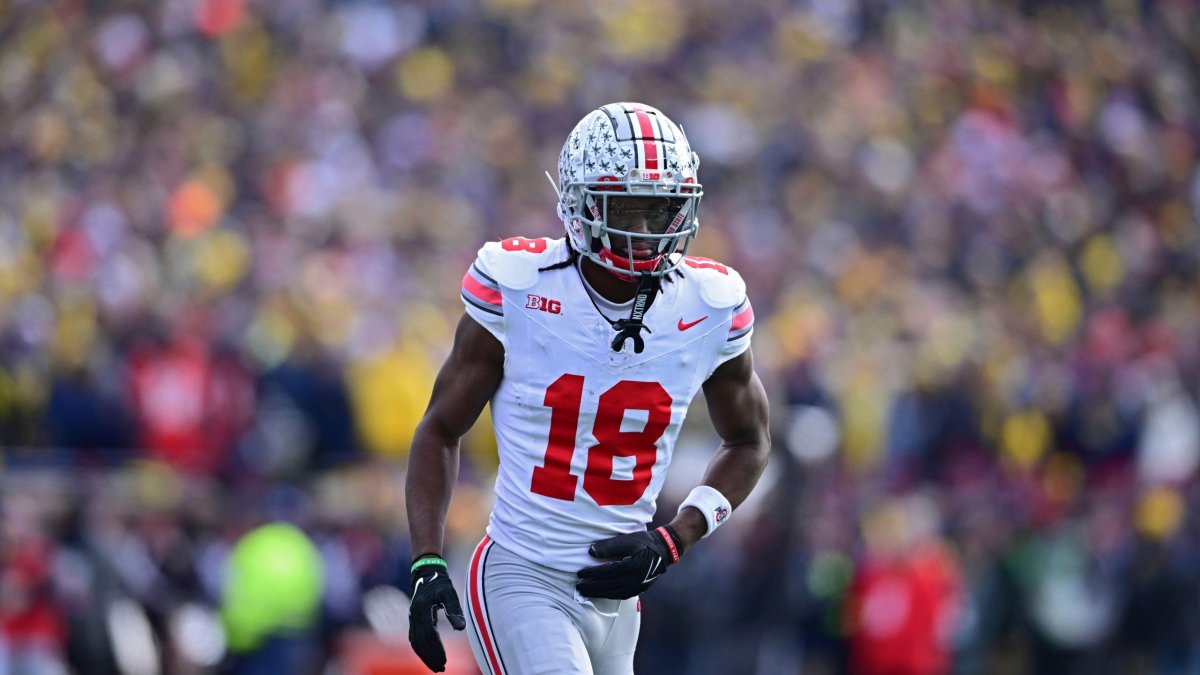• We take a different look at yards per route run to identify potential NFL talent: The top finishers in yards per route run, Marvin Harrison Jr. and Malik Nabers, remain dominant, but concerns emerge for those who did not deliver well over expectations.
• We use historical data to identify potential hits and misses: What do these findings mean for lower finishers in personnel-adjusted yards per route run, such as Adonai Mitchell, Keon Coleman and Brian Thomas Jr.?
• Try PFF's Mock Draft Simulator: You can trade picks and players and draft for your favorite NFL team.
Estimated Reading Time: 8 minutes
Click here for more draft tools:
2024 Mock Draft Simulator | 2024 Big Board | 2024 Draft Guide
2024 Player Profiles | 2024 Mock Drafts | NCAA Premium Stats
One of the most common statistics used in evaluating wide receiver prospects is yards per route run. YPRR is a stable metric, not just from college to the NFL but also year-to-year in the NFL. However, like any single metric, it isn’t perfect in its success rate at identifying future star NFL players.
As highlighted several years ago by former PFFer Zach Drapkin, now a member of the Philadelphia Eagles organization, receiving production often hinges on a player’s usage, and one of the ways we can quantify this is by looking at the different personnel groupings within which receivers run their routes. As highlighted by Drapkin here in 2021, the more wide receivers who are on the field, the fewer opportunities there are to command targets and produce yardage.
While this past study focused on the 2020 NFL season, we examined if it holds true in college football as well. And, as expected, this was the case regardless of year and when expanding to a three-year sample.
Power Five WR Groupings From 2021-2023
| Number of WRs on the Field | Average Yards Per Route Run |
| 1 | 2.03 |
| 2 | 1.95 |
| 3 | 1.39 |
| 4 | 1.23 |
| 5 | 0.89 |
With these numbers in mind, it’s easy to see how wide receivers who are used heavily in certain personnel groupings can gain significant advantages in YPRR. If a wide receiver spends the majority of their snaps in two-wide receiver sets, they should naturally, over the course of a season and/or several seasons, generate a higher YPRR figure than a receiver in an offense that runs more three- or four-wide receiver sets.
Interestingly, the 2024 rookie wide receiver class spent more of their college years in two-wide receiver sets than any of the previous classes, by a significant margin, going back to 2019:
| Season | Average Expected/Personnel-Adjusted YPRR | Average Routes From 2-WR Sets |
| 2024 | 1.62 | 162 |
| 2023 | 1.32 | 115 |
| 2022 | 1.36 | 112 |
| 2021 | 1.39 | 94 |
| 2020 | 1.43 | 106 |
| 2019 | 1.46 | 126 |
As a result of this large gap, the 2024 class had a much higher average personnel-adjusted YPRR total (1.62) than previous groups. This created a slightly lower deviation for most top scorers in total YPRR versus expected YPRR.
Below is a chart, highlighting the top career YPRR numbers for Power Five wide receivers in the 2024 draft class, as well as their expected/personnel-adjusted YPRR figures and deviation from each other. We can then see just how much each receiver was able to perform above expectations.
- Highlighted receivers are expected to be selected within the first three rounds of the 2024 NFL Draft.
- The focus is on wide receivers from Power Five conferences to eliminate some of the noise that comes with competition level.

- The top performers in YPRR are often a result of outperforming expectations, so ideally, their deviations from expected YPRR will remain much higher than their peers.
- Marvin Harrison Jr., Malik Nabers and Troy Franklin are all likely to be highly drafted and show no signs of concern here, remaining among the top four in actual YPRR and in how much they delivered over expectations based on their personnel-adjusted YPRR.
- Rome Odunze and Jamari Thrash increased their rank from outside of the top six in career YPRR to within that range using their personnel-adjusted YPRR score.
First up in the spotlight are the 2024 wide receiver prospects who, as a result of favorable formations, had the highest expected/personnel-adjusted YPRR.

- Ladd McConkey is expected to go in the second round and had the highest expected yards per route run from this year’s class, with the majority of his usage coming in two- and three-wide receiver looks. He also posted the fifth-best career YPRR figure among Power Five wide receivers in this class, which was helped by his favorable situation.
- Adonai Mitchell is a potential first-round pick in this year’s draft, and while he had one of the higher expected YPRR figures based on personnel, his overall deviation from actual and expected YPRR is on the lower end because of his already low actual YPRR total.
Next up are the receivers who saw the greatest fall from where they ranked in career YPRR to their deviation rank when factoring in personnel-adjusted YPRR. Once again, highlighted are the players expected to be selected within the first three rounds of the 2024 NFL Draft, which will be important context.

- Worthy had the sixth-highest expected YPRR total but was the biggest faller of this year’s class when incorporating personnel-adjusted YPRR.
- McConkey was mentioned previously with the highest expected YPRR total of this class, and while he still had a larger deviation number than others in this group, he dropped from fifth to ninth in that regard.
- Keon Coleman is also expected to go in the second round and dropped from the 27th-highest YPRR figure in this class to the 31st when factoring in his personnel-adjusted YPRR.
We are highlighting wide receivers who are expected to be drafted within the first three rounds to show how much lower the hit rate is in the NFL for Rounds 1-3 wide receivers who were unable to create a higher deviation from the rest of their class.
Below is a list of wide receivers drafted in the first three rounds since 2019 who failed to crack the 75th percentile in their deviation score/YPRR over expected, as well as whether those wide receivers also cracked the 75th percentile in PFF wins above replacement at least once in their NFL careers so far — which would have also made them quality starting fantasy assets:
| Wide Receiver | NFL Draft Round | PFF WAR Above 75th Percentile? (NFL) |
| Drake London | 1 | YES |
| Henry Ruggs | 1 | NO |
| N’Keal Harry | 1 | NO |
| Zay Flowers | 1 | YES |
| Jahan Dotson | 1 | NO |
| Jalen Reagor | 1 | NO |
| JJ Arcega-Whiteside | 2 | NO |
| George Pickens | 2 | YES |
| Deebo Samuel | 2 | YES |
| Michael Pittman Jr. | 2 | YES |
| John Metchie II | 2 | NO |
| K.J. Hamler | 2 | NO |
| Alec Pierce | 2 | NO |
| Denzel Mims | 2 | NO |
| Jayden Reed | 2 | NO |
| Terrace Marshall Jr. | 2 | NO |
| Tyquan Thornton | 2 | NO |
| D.K. Metcalf | 2 | YES |
| Chase Claypool | 2 | YES |
| Van Jefferson | 2 | NO |
| Jonathan Mingo | 2 | NO |
| David Bell | 3 | NO |
| Dyami Brown | 3 | NO |
| Anthony Schwartz | 3 | NO |
| Cedric Tillman | 3 | NO |
| Lynn Bowden | 3 | NO |
| Nico Collins | 3 | YES |
| Amari Rodgers | 3 | NO |
| Devin Duvernay | 3 | NO |
| Bryan Edwards | 3 | NO |
| Miles Boykin | 3 | NO |
| Terry McLaurin | 3 | YES |
| Josh Palmer | 3 | NO |
- For those keeping score, the hit rate among prospects drafted within the first three rounds who were unable to crack the top 75th percentile in YPRR over expected is just 24%. This includes Chase Claypool as a hit, as he exceeded the 75th percentile in PFF WAR as a rookie but faded quickly after that.
- Also in this grouping are many of the first-round wide receivers who failed to live up to their draft capital, such as N’Keal Harry, Jalen Reagor and Henry Ruggs III.
- The hit rate for wide receivers who were drafted in the first three rounds and exceeded the 75th percentile threshold in YPRR over expected was more than double (52%).
With this in mind, here are the 2024 wide receivers who saw the lowest deviations from their expected YPRR to actual YPRR, finishing below the 35th percentile in this class (expected Rounds 1-3 wide receivers highlighted):

- Adonai Mitchell stands out as a potential first-round wide receiver in this grouping who also has one of the lowest differences in his career YPRR compared to his expected YPRR. This could be viewed as a red flag when considering the lower hit rates historically for first-round wide receivers who fail to deliver well above their expected YPRR figure.
- Keon Coleman and Xavier Legette also earn some red flags here as potential Day 2 wide receivers who already didn’t stand out in career YPRR. That number becomes slightly more concerning when adjusting for personnel.
- Ja’Lynn Polk, Ricky Pearsall and Brian Thomas Jr. round out this group, with Thomas being the lone expected first-round wide receiver of the three. While his deviation is relatively low compared to the rest of the class, his expected YPRR figure is also among the lowest in the class, which points to less favorable situations for him to deliver a high YPRR number. He should be considered borderline among this group.
Ultimately, the greater focus should be on the wide receivers who performed poorly in personnel-adjusted/expected YPRR, as the success rate in the NFL is significantly higher for those who crush their college metrics compared to those who perform closer to average. This may sound like an obvious statement, but evaluators — both fantasy and NFL-wise — are often taking into account that these college prospects are still developing. This metric helps create more separation among prospects who are closer to being NFL-ready and can be regular fantasy starters.
- To recap, the red-flag players in this class include Adonai Mitchell, who saw the lowest deviation among first-to-third-round wide receivers from his actual YPRR to personnel-adjusted YPRR.
- Keon Coleman and Xavier Legette share similar issues to Mitchell, as they were unable to deliver a strong deviation from personnel-adjusted YPRR to actual YPRR.
- To a lesser extent, Xavier Worthy and Ladd McConkey were two of the biggest fallers in rankings of actual YPRR to where they ranked in deviation/YPRR over expected, with Worthy going from 13th to 21st and McConkey going from fifth to ninth in this class.




 © 2025 PFF - all rights reserved.
© 2025 PFF - all rights reserved.